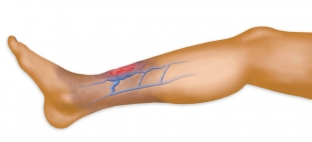Several million people in the world suffer from trophic ulcers of the lower extremities. Treatment of trophic ulcers of the lower extremities today causes many difficulties, despite the rapid development of medicine. Trophic ulcers are a process that does not develop independently, but is the result of a chronic long-term pathological process in the body. This is the complexity of the treatment of trophic disorders - to determine and eliminate the cause. What are trophic ulcers, and how to determine the cause by the symptoms, read on estet-portal.com.
What are the types of trophic ulcers of the lower extremities?
For treatment, it is necessary to determine the type of trophic ulcer and, therefore, the cause of its occurrence. There are several types of trophic ulcers of the lower extremities:
- Arterial (or atherosclerotic) trophic ulcer.
- Venous trophic ulcer.
- Diabetic trophic ulcer.
- Neurotrophic ulcer.
- Martorella ulcers (hypertonic).
- Pyogenic trophic ulcer.
Let's consider the causes and manifestations of these types of trophic ulcers of the lower extremities.
Arterial trophic ulcer of the lower extremities
Arterial ulcer of the lower extremities develops against the background of obliterating atherosclerosis of the main arteries of the lower extremities, aortic aneurysm. Manifestations of vascular obliteration and the development of trophic ulcers of the lower extremities begin after hypothermia, violation of the integrity of the skin of the limb or after wearing tight uncomfortable shoes.
Ulcers are located on the outer surface of the foot, on the inner surface of the fingers and the heel. The presence of arterial trophic ulcers of the lower extremities indicates critical ischemia in the tissue of the extremity, which, without treatment, can result in gangrene and amputation. Ulcers look like small round tissue defects with torn edges filled with purulent contents. Often trophic ulcers on the background of atherosclerosis affect the elderly.
A distinctive feature of arterial trophic ulcers – the presence of intermittent claudication before the appearance of ulcers. The legs are cold to the touch, it is difficult for the patient to climb stairs, at night there is aching pain in the legs. The limb quickly freezes and gets tired.
Venous trophic ulcers of the lower extremities
Such ulcers appear as a result of varicose veins or thrombosis of the veins of the lower extremities. Venous trophic ulcers of the lower extremities are a consequence of the discharge of blood from the deep veins into the superficial veins of the lower extremities. At the same time, the blood stagnates in the superficial veins, and the skin acquires a purple-bluish hue.
Venous trophic ulcers affect the area of the legs of the lower extremities from the inside. Symptoms of trophic ulcers of the lower extremities with venous disorders begin with a feeling of heaviness and the presence of swelling of the legs, convulsions appear at night. Then the skin of the lower leg begins to itch, a noticeable network of dilated saphenous veins appears on it.
Later, the skin acquires a purple-bluish tint, then it becomes elastic, stretched, has a shine and smoothness. At this stage, whitish plaques appear that resemble paraffin flakes. In this condition, the legs of the lower extremities, if left untreated, can be complicated by thrombophlebitis, lymphadenitis or erysipelas and sepsis.

Hypertensive trophic ulcer of the lower extremities
Hypertensive trophic ulcer of the lower extremities is called Martorell's ulcer. It appears against the background of malignant arterial hypertension. With a constant increase in pressure, hyalinosis of the walls of small vessels occurs, which provokes a prolonged vasospasm. A small spot of red-bluish color with slight pain appears on the skin.
Hypertensive trophic ulcers of the lower extremities often affect women over 40 years of age. A distinctive feature of this type of ulcer is that changes on the skin appear symmetrically, being localized in the middle part of the outer surface of the limb. Also, ulcers are characterized by very slow development, accompanied by excruciating pain day and night in the lower extremities. Hypertensive ulcers are most prone to bacterial damage.
Neurotrophic type of trophic ulcer of the lower extremities
Neurotrophic ulcer of the lower extremities appears after head or spine injuries, in demyelinated diseases, which are accompanied by damage to the nerve structure, and the innervation of the limb is lost. Ulcers form on the sides of the foot or on the side of the heel tubercle. Such trophic ulcers are characterized by small size, but significant depth and have the appearance of a crater. The bottom of such a trophic ulcer of the lower extremities can be represented by muscles, bones or tendons. The contents of a serous-purulent nature with an unpleasant odor are released from the ulcer.
Diabetic and pyogenic trophic ulcer of the lower extremities
A diabetic trophic ulcer of the lower extremities develops against the background of diabetes mellitus and is its complication. The process begins from a violation of the structure and function of the nerve plexuses of the limb due to diabetic neuropathy. The skin of the leg becomes cold to the touch due to a violation of innervation. Ulcers often appear on the thumbs, may be on the heel and sole. Symptoms are similar to arterial trophic ulcers of the lower extremities, but are marked by the absence of lameness and deeper ulcers.
Pyogenic ulcers develop in people with low social status against the background of a decrease in immunity after furunculosis, purulent eczema and folliculitis. Pyogenic trophic ulcers appear when personal hygiene is not observed. They are oval in shape and shallow in depth.
Knowing the type of trophic ulcer makes treatment faster, more effective and safer.







Add a comment